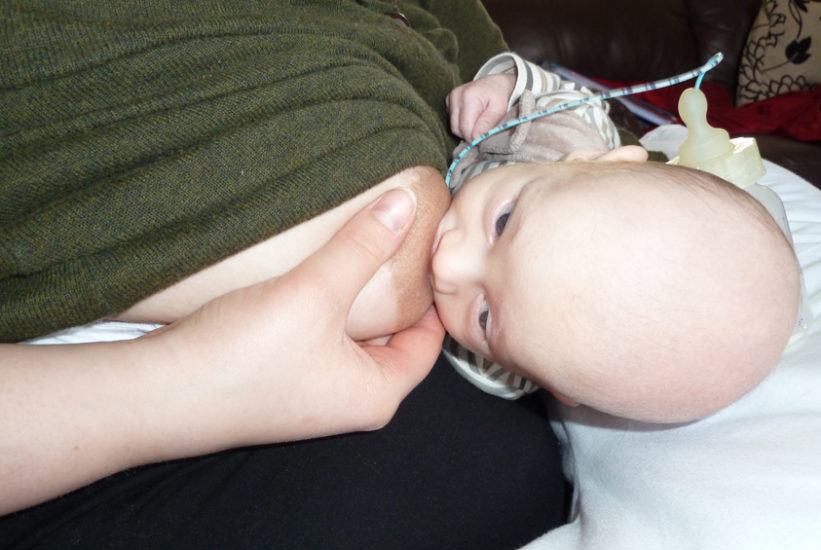Can Newborn Relatch to Breast After Bottle Feeding
Sometimes breastfeeding doesn't get off to a good start and before you know it your baby is taking more and more bottles and won't breastfeed at all. Getting a baby back to breastfeeding after a period of bottle feeding can take some patience and perseverance, but it is definitely possible. If your breast milk supply has dropped then in addition to getting baby from bottle to breast you may have to build your milk supply or relactate. This article reviews how to get baby back to breast after a period of bottle feeding.
Tips to get started
- Build your breast milk supply by regular pumping or hand expression as needed or see our Tips for Relactation
- Keep your baby well fed while he practices breastfeeding so he doesn't learn to associate hunger and frustration with the breast. Being hungry won't force a baby to breastfeed well.
- Stay calm—practice breastfeeding without pressure, relax your shoulders and try not to look tense, smile! Follow your baby's cues if he seems stressed and try again at another feed.
- Be patient—it can take a while for a baby to learn something new but lots of babies have made the change from bottle to breast. Never try to force your baby to the breast as this will be counterproductive.
How to get baby back to breast
Skin-to-skin
Babies have a strong instinct to breastfeed and their instincts tend to be at their strongest when they are held close to the breast in skin-to-skin contact. Try holding your baby next to the naked breast without pressure to latch on (attach to the breast). The fewer clothes between you the better.
- Remember to take off any scratch mittens so your baby can use his hands and tune into all his natural feeding reflexes.
- Relaxing in the bath together in low lighting with your baby between your breasts can encourage feeding reflexes.
- Using a sling around the house can give your baby easy access to the breast.
- Don't worry if your baby doesn't try to latch during his first time skin-to-skin—the important thing is to help your baby associate the breast with a warm, relaxing and safe place to be with the opportunity to breastfeed when he is ready.
Try different breastfeeding positions
The way a baby is held at the breast can help or hinder latching. In the right position many babies can latch on all by themselves. Laid back or reclining positions can be particularly helpful with self latching. Our articles Breastfeeding Positions for Newborns and Breastfeeding Videos describe the main breastfeeding positions. If you're not sure of the best way to hold your baby, contact your breastfeeding helper or IBCLC Lactation Consultant, it will really help to have an experienced cheer leader at your side.
Avoid using a dummy or pacifier
A dummy or pacifier encourages a different suck to the one required for a good latch on the breast and also takes the place of the breast as main comforter. Try to reduce reliance on a dummy by offering the breast and skin-to-skin contact as the comfort for your baby instead. Letting a baby suck on a clean finger can also help to introduce a baby to the feeling of skin in their mouth as a comforter instead of a silicone teat.
Avoid using a bottle for some or all feeds
One way to encourage a baby to breastfeed is to reduce their reliance on a bottle teat to pave the way for a different feeding method. Alternatives such as cup feeding or finger feeding can encourage breastfeeding by helping to break a baby's association of food with artificial teats.
- Cup feeding. Even very young babies can feed from an open cup when it is done carefully see Cup Feeding a Breastfed Baby for videos and more information.
- Finger feeding. Finger feeding involves a baby sucking a parent's finger with a narrow gauge supplemental feeding tube held or taped alongside, through which the milk flows when baby sucks. The sucking technique needed for finger feeding is said to be closer to breastfeeding than bottle feeding, and finger feeding can introduce a baby to the feeling of skin in their mouth instead of a silicone teat. See What is Finger Feeding? for more information. After a little finger feeding to calm your baby and take the edge off his appetite, you could try moving him to the breast. Ensure your breast is soft and not over full to help him grasp the breast tissue to form a teat shape.
Make a bottle feed more like a breastfeed
If you can't avoid bottles yet, try to make bottle feeding more like breastfeeding by following these tips to bottle feed a breastfed baby. When bottle feeding is more similar to breastfeeding it can help a baby transition between the two ways of feeding more easily. The shape of the teat, the flow rate and the way you offer milk in a bottle can help or hinder breastfeeding. Some mothers hide the bottle in a cloth and keep baby next to a naked breast during their feed to help them associate the breast with milk.
Nipple shields—make a breast more like a bottle
Nipple shields are small silicone covers with holes in the tip that fit over a nipple. Because a nipple shield will feel and taste closer to a bottle teat this can be a helpful bottle-to-breast transitioning tool for babies who are already used to bottles. It may be helpful to try it when your baby is sleepy or in light sleep and with a breast full of milk. Expressing a little milk into the end of the shield will give your baby an instant reward if he latches. Some breast compressions can help keep your baby's interest if he does latch. Breast compressions involve applying gentle pressure to your breast to stimulate milk flow—be sure to keep your fingers far enough from your nipple so that you don't disturb your baby's latch. See Nipple Shields Good or Bad? and What is Breast Compression? for further information.
Some mothers have had success with latching by placing a bottle teat over their nipple for a practice session. Make sure this doesn't rub and make you feel sore.
A sleepy baby may latch
When your baby is in a light sleep or not frantically hungry bring him skin-to-skin next to a full breast; he may latch in his sleep. Or hold your baby for a full sleep cycle in your arms and offer the breast when you see the earliest feeding cues. It can help if you can initiate the let-down (milk release) before your baby goes on to the breast so that there is an instant reward of milk. If your baby latches, some gentle breast compressions can increase milk flow. A dark and quiet room can be helpful to avoid distractions for your baby. See Bed-Sharing With Baby for safety information if you are considering bed-sharing.
Try switching between bottle and breast
Switching from a bottle to the breast half way through a feed has worked for some mothers by slipping the bottle teat out of baby's mouth and quickly moving them onto the breast before they notice. If baby hesitates at the feel of skin in their mouth a little gentle rocking or movement can encourage them to continue with the latch.
Use play and humour
For a slightly older baby, using new positions in a playful way may help turn breastfeeding into more of a casual fun thing, rather than an activity that creates tension and anxiety. Trying different positions and places for latching on—in the bath, the garden, kitchen, while walking about, in a dark room, even dangling a breast over him when he is on the floor (while you both giggle)—may all help make it more of a fun thing to do. Sometimes being inventive and making a silly game involving breastfeeding may work.
Watch other mothers and babies breastfeed
It can be helpful to spend time with other breastfeeding mothers for support and ideas. An older baby may be interested to copy other babies breastfeeding.
Once your baby latches…
Full breast or empty breast?
Try to strike a balance between offering a soft breast which will be easier for a latch, and a breast that is full enough to give an instant reward of plentiful milk. Shaping your breast ie compressing it/flattening it slightly to fit your baby's mouth can help your baby latch (i.e. the same way you might flatten a big sandwich full of lettuce before you take a bite). See Latching Tips for further help.
Stay relaxed
The first time your baby latches to the breast will be very exciting, you may find you tense up or hold your breath. Try to relax and act like this is natural and nothing special! You could sway slightly or rock your baby gently at this point. Some mothers have tried singing or chatting to their baby while their little one latches. The next step is providing an instant reward for any suckling, either via a full breast and an already initiated let-down or by breast compressions or with a supplemental nursing system (see below). As soon as your baby is taking good volumes at the breast try to phase out using the bottle for any top-ups so your baby can learn to breastfeed without nipple confusion.
Supplemental nursing system
If your milk supply is very low, supplementing at the breast with a homemade or commercial supplemental nursing system can help transition baby back to breast once they begin to latch. If your baby is latched correctly the thin feeding tube of the supplementer runs alongside the nipple or nipple shield delivering plenty of breast milk or formula. This helps give your baby a positive association with the breast as a food source and will also stimulate your own supply simply by baby being latched on. It can be fiddly and take some practice, and bear in mind an older baby may be aware of the tube at first. See Breastfeeding With a Supplemental Nursing System for more information.
Finish at the breast
If your baby is still having supplements by bottle but has started to latch, it can sometimes work well to offer most (but not all) of the supplemental feed first and then finish with a breastfeed. This way a baby learns to fall asleep full and contented at the breast. As your supply increases and baby's technique improves less supplement can be offered before the feed so that the bottle is gradually phased out.
If breastfeeding hurts…
Working with an IBCLC lactation consultant when you are trying to get your baby back to the breast can be a great support. There may be good reasons why breastfeeding didn't work out the first time and it can help a great idea to talk these through. Maybe it was because breastfeeding hurt because your baby was in a shallow latch, or you didn't think you had enough milk, or you had flat or inverted nipples. Knowing answers to common problems can help prepare you for any blips in your bottle-to-breast journey. Your lactation consultant will be able to make suggestions to improve latch, positioning and tongue function.
Trouble shooting
Baby crying, arching and pulling away?
Sometimes a baby may seem quite distressed by breastfeeding or even the thought of breastfeeding. He might arch his back and pull away from the breast every time his mother tries to latch him, he may get very upset and cry. This might happen when a baby associates a negative experience with breastfeeding such as being pushed onto the breast when he is upset/crying or having their head held in position when they are trying to get away from the breast. Sometimes well meaning health professionals can cause this by their attempts to make a baby to breastfeed. Or a mother may inadvertently perpetuate it by repeating the technique. Once a baby is upset, a mother will get upset too and the tension around breastfeeding can be reinforced with every feed. Taking a short break from trying to breastfeed can help to break this negative pattern.
Take a break
Taking a break from trying to breastfeed for a few days might feel counterproductive, but making breasts a happy place (mamaandbabylove.com) can reset your baby's bad memories. Substitute breastfeeding efforts with lots of skin-to-skin contact without any pressure on your part to get your baby to latch. Try breastfeeding again in a few days using breastfeeding positions that give your baby more control of how and when to latch. Christina Smillie describes a step by step approach in her handout Time Off to "Reboot" the Baby and Get Over Breast Distress.
Stay calm
Babies breastfeed best when they are calm and alert. Choose a moment to try breastfeeding when your baby is calm, and help your baby stay calm by talking to him, reassuring him, maintaining eye contact and staying calm yourself 1.
Summary
Just as many breastfed babies can be persuaded to take a bottle, it is possible to get a baby to take the breast after a period of bottle feeding. It can take some patience and perseverance but there are several tips and tricks to try even if your baby is several weeks or months old.
Source: https://breastfeeding.support/how-to-get-baby-back-to-breast/



0 Response to "Can Newborn Relatch to Breast After Bottle Feeding"
Post a Comment